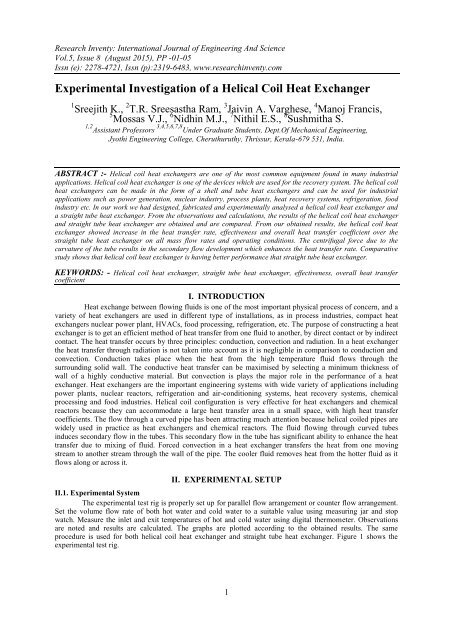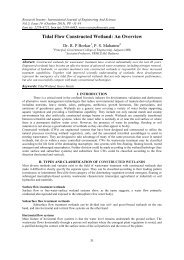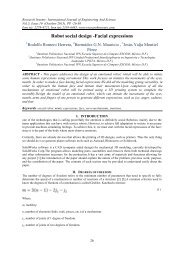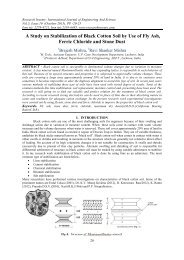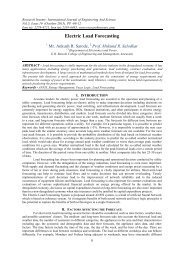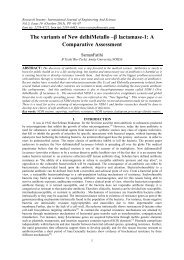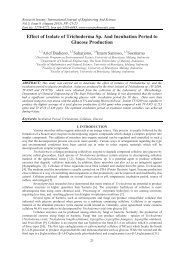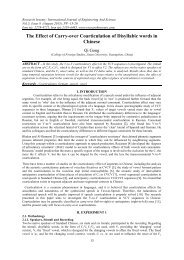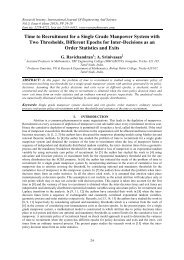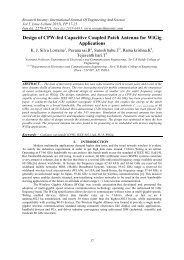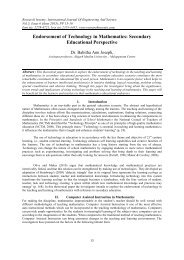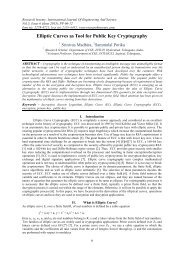Experimental Investigation of a Helical Coil Heat Exchanger
- No tags were found...
Create successful ePaper yourself
Turn your PDF publications into a flip-book with our unique Google optimized e-Paper software.
Research Inventy: International Journal <strong>of</strong> Engineering And Science<br />
Vol.5, Issue 8 (August 2015), PP -01-05<br />
Issn (e): 2278-4721, Issn (p):2319-6483, www.researchinventy.com<br />
<strong>Experimental</strong> <strong>Investigation</strong> <strong>of</strong> a <strong>Helical</strong> <strong>Coil</strong> <strong>Heat</strong> <strong>Exchanger</strong><br />
1 Sreejith K., 2 T.R. Sreesastha Ram, 3 Jaivin A. Varghese, 4 Manoj Francis,<br />
5 Mossas V.J., 6 Nidhin M.J., 7 Nithil E.S., 8 Sushmitha S.<br />
1,2 Assistant Pr<strong>of</strong>essors<br />
3,4,5,6,7,8 Under Graduate Students, Dept.Of Mechanical Engineering,<br />
Jyothi Engineering College, Cheruthuruthy, Thrissur, Kerala-679 531, India.<br />
ABSTRACT :- <strong>Helical</strong> coil heat exchangers are one <strong>of</strong> the most common equipment found in many industrial<br />
applications. <strong>Helical</strong> coil heat exchanger is one <strong>of</strong> the devices which are used for the recovery system. The helical coil<br />
heat exchangers can be made in the form <strong>of</strong> a shell and tube heat exchangers and can be used for industrial<br />
applications such as power generation, nuclear industry, process plants, heat recovery systems, refrigeration, food<br />
industry etc. In our work we had designed, fabricated and experimentally analysed a helical coil heat exchanger and<br />
a straight tube heat exchanger. From the observations and calculations, the results <strong>of</strong> the helical coil heat exchanger<br />
and straight tube heat exchanger are obtained and are compared. From our obtained results, the helical coil heat<br />
exchanger showed increase in the heat transfer rate, effectiveness and overall heat transfer coefficient over the<br />
straight tube heat exchanger on all mass flow rates and operating conditions. The centrifugal force due to the<br />
curvature <strong>of</strong> the tube results in the secondary flow development which enhances the heat transfer rate. Comparative<br />
study shows that helical coil heat exchanger is having better performance that straight tube heat exchanger.<br />
KEYWORDS: - <strong>Helical</strong> coil heat exchanger, straight tube heat exchanger, effectiveness, overall heat transfer<br />
coefficient<br />
I. INTRODUCTION<br />
<strong>Heat</strong> exchange between flowing fluids is one <strong>of</strong> the most important physical process <strong>of</strong> concern, and a<br />
variety <strong>of</strong> heat exchangers are used in different type <strong>of</strong> installations, as in process industries, compact heat<br />
exchangers nuclear power plant, HVACs, food processing, refrigeration, etc. The purpose <strong>of</strong> constructing a heat<br />
exchanger is to get an efficient method <strong>of</strong> heat transfer from one fluid to another, by direct contact or by indirect<br />
contact. The heat transfer occurs by three principles: conduction, convection and radiation. In a heat exchanger<br />
the heat transfer through radiation is not taken into account as it is negligible in comparison to conduction and<br />
convection. Conduction takes place when the heat from the high temperature fluid flows through the<br />
surrounding solid wall. The conductive heat transfer can be maximised by selecting a minimum thickness <strong>of</strong><br />
wall <strong>of</strong> a highly conductive material. But convection is plays the major role in the performance <strong>of</strong> a heat<br />
exchanger. <strong>Heat</strong> exchangers are the important engineering systems with wide variety <strong>of</strong> applications including<br />
power plants, nuclear reactors, refrigeration and air-conditioning systems, heat recovery systems, chemical<br />
processing and food industries. <strong>Helical</strong> coil configuration is very effective for heat exchangers and chemical<br />
reactors because they can accommodate a large heat transfer area in a small space, with high heat transfer<br />
coefficients. The flow through a curved pipe has been attracting much attention because helical coiled pipes are<br />
widely used in practice as heat exchangers and chemical reactors. The fluid flowing through curved tubes<br />
induces secondary flow in the tubes. This secondary flow in the tube has significant ability to enhance the heat<br />
transfer due to mixing <strong>of</strong> fluid. Forced convection in a heat exchanger transfers the heat from one moving<br />
stream to another stream through the wall <strong>of</strong> the pipe. The cooler fluid removes heat from the hotter fluid as it<br />
flows along or across it.<br />
II. EXPERIMENTAL SETUP<br />
II.1. <strong>Experimental</strong> System<br />
The experimental test rig is properly set up for parallel flow arrangement or counter flow arrangement.<br />
Set the volume flow rate <strong>of</strong> both hot water and cold water to a suitable value using measuring jar and stop<br />
watch. Measure the inlet and exit temperatures <strong>of</strong> hot and cold water using digital thermometer. Observations<br />
are noted and results are calculated. The graphs are plotted according to the obtained results. The same<br />
procedure is used for both helical coil heat exchanger and straight tube heat exchanger. Figure 1 shows the<br />
experimental test rig.<br />
1
<strong>Experimental</strong> <strong>Investigation</strong> <strong>of</strong>…<br />
Figure 1: <strong>Experimental</strong> Test Rig<br />
II.2. <strong>Experimental</strong> Procedure<br />
Schematic diagrams <strong>of</strong> the experimental apparatus <strong>of</strong> the helical coil and straight tube heat exchangers<br />
are shown in Figures 2 & 3. The valves are properly adjusted to set the volume flow rate <strong>of</strong> both hot water and<br />
cold water. The system was operated at parallel flow and counter flow arrangements. At each condition the inlet<br />
and exit temperatures <strong>of</strong> hot and cold water was measured using digital thermometer. Observations are noted<br />
and results are calculated.<br />
Figure 2: Schematic diagram <strong>of</strong> the helical coil heat exchanger<br />
Figure 3: Schematic diagram <strong>of</strong> the straight tube heat exchanger<br />
The experiment was done until steady state condition was attained. The performance <strong>of</strong> the helical coil<br />
heat exchanger and straight tube heat exchangers are analysed accordingly.<br />
III. RESULTS AND DISCUSSIONS<br />
Figure 4 gives the variation <strong>of</strong> effectiveness with inlet temperature <strong>of</strong> hot water for both helical coil and<br />
straight tube heat exchangers. It is found that the effectiveness <strong>of</strong> helical coil heat exchanger is found to be<br />
higher when compared to that <strong>of</strong> the straight tube heat exchanger for all the inlet temperatures. From this result<br />
it is found that the helical coil heat exchanger is having better effectiveness than straight tube heat exchanger.<br />
2
<strong>Experimental</strong> <strong>Investigation</strong> <strong>of</strong>…<br />
Figure 4: Variation <strong>of</strong> effectiveness with inlet temperature <strong>of</strong> hot water<br />
Figure 5 shows the the variation <strong>of</strong> overall heat transfer coefficients with inlet temperature <strong>of</strong> hot water<br />
for both helical coil and straight tube heat exchangers. It is found that the overall heat transfer coefficients <strong>of</strong><br />
helical coil heat exchanger are found to be higher when compared to that <strong>of</strong> the straight tube heat exchanger for<br />
all the inlet temperatures. From this result it is found that the helical coil heat exchanger is having better overall<br />
heat transfer coefficients than straight tube heat exchanger.<br />
Figure 5: Variation <strong>of</strong> overall heat transfer with inlet temperature <strong>of</strong> hot water<br />
The experimental results indicated that helical coil heat exchanger showed increase in the heat transfer<br />
rate, effectiveness and overall heat transfer coefficient over the straight tube heat exchanger on all mass flow<br />
rates and operating conditions. These results confirmed that the performance <strong>of</strong> the helical coil heat exchanger is<br />
better than straight tube heat exchanger.<br />
Table I<br />
<strong>Experimental</strong> observations <strong>of</strong> inlet temperature <strong>of</strong> hot water Vs effectiveness for helical coil and straight tube<br />
heat exchangers<br />
3
<strong>Experimental</strong> <strong>Investigation</strong> <strong>of</strong>…<br />
Table II<br />
<strong>Experimental</strong> observations <strong>of</strong> overall heat transfer coefficients Vs inlet temperature <strong>of</strong> hot water for helical coil<br />
and straight tube heat exchangers<br />
IV. CONCLUSIONS<br />
<strong>Experimental</strong> analysis for a helical coil heat exchanger was carried out and the results are compared<br />
with the straight coil under similar geometrical and operating conditions. The results <strong>of</strong> the helical coil heat<br />
exchanger are compared with the straight tube heat exchanger in parallel flow by varying parameters like<br />
temperature, flow rate <strong>of</strong> cold water and hot water. Based on the results obtained by conducting the experiments<br />
on helical (parallel flow) and straight (parallel flow) tube, the following conclusions are drawn.<br />
The main conclusions are listed as follows:<br />
1) The helical tube allows the fluid to be in contact for greater period <strong>of</strong> time so that there is an enhanced<br />
heat transfer compared to that <strong>of</strong> straight tube.<br />
2) Comparative study is carried out between helical coil heat exchanger and straight tube heat exchanger.<br />
The effectiveness and overall heat transfer coefficient <strong>of</strong> heat exchanger greatly affected by the hot<br />
water mass flow rate and cold water flow rate. When cold water mass flow rate is constant and hot<br />
water mass flow rate is increased both the effectiveness as well as the overall heat transfer coefficient<br />
increases.<br />
3) Results indicated that helical coil heat exchanger showed increase in the heat transfer rate,<br />
effectiveness and overall heat transfer coefficient over the straight tube heat exchanger on all mass flow<br />
rates and operating conditions.<br />
4) The centrifugal force due to the curvature <strong>of</strong> the tube results in the secondary flow development which<br />
enhances the heat transfer rate.<br />
5) Comparative study shows that helical coil heat exchanger is having better performance that straight<br />
tube heat exchanger.<br />
ACKNOWLEDGEMENT<br />
This study was supported by the UG section, Department <strong>of</strong> Mechanical Engineering, Jyothi Engineering<br />
College, Thrissur-679 531, Kerala, India.<br />
REFERENCES<br />
[1] Swapnil Ahire, Purushottam Shelke, Bhalchandra Shinde, Nilesh Totala, “Fabrication and Analysis <strong>of</strong> Counter Flow <strong>Helical</strong> <strong>Coil</strong><br />
<strong>Heat</strong> <strong>Exchanger</strong>”, International Journal <strong>of</strong> Engineering Trends and Technology (IJETT) – Volume 15 Number 5, (September<br />
2014).<br />
[2] B. Chinna Ankanna, B. Sidda Reddy, “Performance Analysis <strong>of</strong> Fabricated <strong>Helical</strong> <strong>Coil</strong> <strong>Heat</strong> <strong>Exchanger</strong>”, International Journal<br />
<strong>of</strong> Engineering Research, Volume No.3, Issue No: Special 1, pp: 33-39 (March 2014).<br />
[3] Shiva Kumar, K.Vasudev Karanth, “Numerical Analysis <strong>of</strong> a <strong>Helical</strong> <strong>Coil</strong>ed <strong>Heat</strong> <strong>Exchanger</strong> using CFD”,International Journal <strong>of</strong><br />
Thermal Technologies, Vol.3, No.4, (December 2013).<br />
4
5<br />
<strong>Experimental</strong> <strong>Investigation</strong> <strong>of</strong>…


